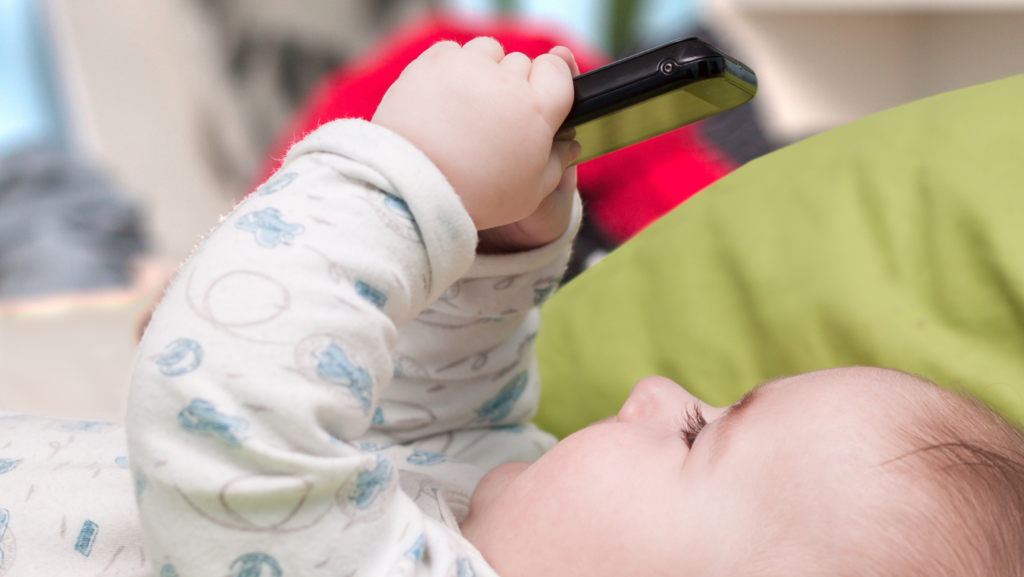Abstract
Objective:
The objective was to examine the association between mobile media device use and communication delays in 18-month-old children.
Methods:
A cross-sectional study was conducted from September 2011 and December 2015 within the TARGet Kids! primary care research network. Children were included if parents reported their child’s mobile media device use and completed a validated questionnaire for communication delay at the 18-month well child visit. Mobile media device use was measured using a parent-reported survey instrument. Daily mobile media device use was calculated as a weighted average of typical weekday and weekend day mobile media device use. Two communication outcomes were investigated: (1) expressive speech delay and (2) other communication delays, as measured by the Infant Toddler Checklist.
Results:
The study sample included 893 children (mean age 18.7 months, 54.1% male). Most parents reported 0 minutes per day of mobile media device use in their children (n = 693, 77.6%). Among children whose parents reported any mobile media device use (n = 200, 22.4%), the median daily mobile media device use was 15.7 minutes (range 1.4–300). The prevalence of parent-reported expressive speech delay was 6.6%, and the prevalence of other parent-reported communication delays was 8.8%. For children who used a mobile media device, each additional 30-minute increase in daily mobile media device use was associated with increased odds of parent-reported expressive speech delay (ORa = 2.33, 95% confidence interval, 1.25–4.82). No relationship was observed between mobile media device use and other parent-reported communication delays.
Conclusion:
Our study demonstrated a significant association between mobile media device use and parent-reported expressive speech delay in 18-month-old children.
References:
1.
Christakis DA, Gilkerson J, Richards J, et al. Audible television and decreased adult words, infant vocalizations, and conversational turns. Arch Pediatr Adolesc Med. 2009;163:554–558. [PubMed] [Google Scholar]2.
Courage ML, Howe ML. To watch or not to watch: infants and toddlers in a brave new electronic world. Dev Rev. 2010;30:101–115. [Google Scholar]4.
Kabali HK, Irigoyen MM, Nunez-Davis R, et al. Exposure and use of mobile media devices by young children. Pediatrics. 2015;136:1044–1050. [PubMed] [Google Scholar]6.
Radesky JS, Schumacher J, Zuckerman B. Mobile and interactive media use by young children: the good, the bad, and the unknown. Pediatrics. 2015;135:1–3. [PubMed] [Google Scholar]7.
Parish-Morris J, Mahajan N, Hirsh-Pasek K, et al. Once upon a time: parent–child dialogue and storybook reading in the electronic era. Mind Brain Educ. 2011;7:200–211. [Google Scholar]8.
Roseberry S, Hirsh-Pasek K, Golinkoff RM. Skype Me! socially contingent interactions help toddlers learn language. Child Dev. 2014;85:956–970. [PMC free article] [PubMed] [Google Scholar]9.
American Academy of Pediatrics Council on Communications and Media. Media and young minds. Pediatrics. 2016;138:e20162591. [PubMed] [Google Scholar]10.
Lavigne M, Birken CS, Maguire JL, et al. Priority setting in paediatric preventive care research. Arch Dis Child. 2017;102:748–753. [PubMed] [Google Scholar]11.
Radesky JS, Eisenberg S, Gross J, et al. Overstimulated consumers or next-generation learners? Parent tensions about child mobile technology use. Ann Fam Med. 2016;14:503–508. [PMC free article] [PubMed] [Google Scholar]12.
Kildare CA, Middlemiss W. Impact of parents mobile device use on parent-child interaction: a literature review. Comput Hum Behav. 2017;75:579–593. [Google Scholar]13.
Carsley S, Borkhoff CM, Maguire JL, et al. Cohort profile: the applied research Group for Kids (TARGet Kids!). Int J Epidemiol. 2015;44:776–788. [PMC free article] [PubMed] [Google Scholar]15.
Eadie PA, Ukoumunne O, Skeat J, et al. Assessing early communication behaviours : structure and validity of the communication and symbolic behaviour scales—developmental profile (CSBS-DP) in 12-month-old infants. Int J Lang Comun Disord. 2010;45:572–585. [PubMed] [Google Scholar]16.
Wetherby AM, Brosnan-Maddox S, Peace V, et al. Validation of the Infant-Toddler Checklist as a broadband screener for autism spectrum disorders from 9 to 24 months of age. Autism. 2008;12:487–511. [PMC free article] [PubMed] [Google Scholar]17.
Perez-Pereira M, Fernandez P, Resches M, et al. Does temperament influence language development? Evidence from preterm and full-term children. Infant Behav Dev. 2016;42:11–21. [PubMed] [Google Scholar]18.
Radesky JS, Silverstein M, Zuckerman B, et al. Infant self-regulation and early childhood media exposure. Pediatrics. 2014;133:e1172–e1178. [PMC free article] [PubMed] [Google Scholar]19.
Laake LM, Bridgett DJ. Happy babies, chatty toddlers: infant positive affect facilitates early expressive, but not receptive language. Infant Behav Dev. 2014;37:29–32. [PMC free article] [PubMed] [Google Scholar]20.
Jago R, Sebire SJ, Lucas PJ, et al. Parental modelling, media equipment and screen-viewing among young children: cross-sectional study. BMJ Open. 2013;3:1–6. [PMC free article] [PubMed] [Google Scholar]21.
Thompson DA, Tschann JM. Factors contributing to background television exposure in low-income Mexican-American preschoolers. Matern Child Health J. 2016;20:1835–1841. [PMC free article] [PubMed] [Google Scholar]22.
Carson V, Janssen I. Associations between factors within the home setting and screen time among children aged 0–5 years: a cross-sectional study. BMC Public Health. 2012;12:539. [PMC free article] [PubMed] [Google Scholar]23.
Putnam SP, Helbig AL, Gartstein MA, et al. Development and assessment of short and very short forms of the infant behavior questionnaire-revised. J Pers Assess. 2014;96:445–458. [PubMed] [Google Scholar]24.
Putnam SP, Gartstein MA, Rothbart MK. Measurement of fine-grained aspects of toddler temperament: the early childhood behavior questionnaire. Infant Behav Dev. 2006;29:386–401. [PMC free article] [PubMed] [Google Scholar]25.
Zimmerman F, Christakis D, Meltzoff AN. Associations between media viewing and language development in children under age 2 years. J Pediatr. 2007;151:364–368. [PubMed] [Google Scholar]26.
Powers S, Li JM. Media and technology in the lives of infants and toddlers. J Zero Three. 2013;33:11–16. [Google Scholar]27.
Barr R. Memory Constraints on infant learning from picture books, television, and touchscreens. Child Dev Perspect. 2013;7:205–210. [Google Scholar]28.
Kirkorian HL, Pempek TA, Murphy LA, et al. The impact of background television on parent – child interaction. Child Dev. 2009;80:1350–1359. [PubMed] [Google Scholar]29.
Cheung CHM, Bedford R, Saez De Urabain IR, et al. Daily touchscreen use in infants and toddlers is associated with reduced sleep and delayed sleep onset. Sci Rep. 2017;7:1–7. [PMC free article] [PubMed] [Google Scholar]30.
Radesky J, Peacock-Chambers E, Zuckerman B, et al. Use of mobile technology to calm upset children: associations with social-emotional development. JAMA Pediatr. 2016;170:397–399. [PubMed] [Google Scholar]31.
Kuhn L, Willourghby M, Wilbourn M, et al. Early communicative gestures prospectively predict language development and executive function in early childhood. Child Dev. 2014;85:1898–1914. [PMC free article] [PubMed] [Google Scholar]

